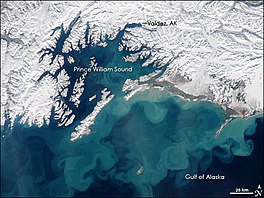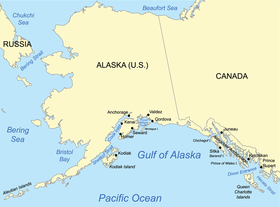| Gulf of Alaska | |
|---|---|
 A view of the Gulf of Alaska from space, showing swirling sediment in the waters | |
| Location | South shore of Alaska |
| Coordinates | 57°N 144°W / 57°N 144°W |
| Type | Gulf |
| Part of | North Pacific Ocean |
| River sources | Susitna River |
| Ocean/sea sources | Pacific Ocean |
| Basin countries | Canada and United States |
| Surface area | 1,533,000 km2 (592,000 sq mi) |
| Islands | Kodiak Archipelago, Montague Island, Middleton Island, Alexander Archipelago |
| Settlements | Anchorage, Juneau |
The Gulf of Alaska (Tlingit: Yéil T'ooch’)[1] is an arm of the Pacific Ocean defined by the curve of the southern coast of Alaska, stretching from the Alaska Peninsula and Kodiak Island in the west to the Alexander Archipelago in the east, where Glacier Bay and the Inside Passage are found.
The Gulf shoreline is a combination of forest, mountain and a number of tidewater glaciers. Alaska's largest glaciers, the Malaspina Glacier and Bering Glacier, spill out onto the coastal line along the Gulf of Alaska. The coast is heavily indented with Cook Inlet and Prince William Sound, the two largest connected bodies of water. It includes Yakutat Bay and Cross Sound. Lituya Bay (a fjord north of Cross Sound, and south of Mount Fairweather) is the site of the largest recorded tsunami in history. It serves as a sheltered anchorage for fishing boats.

The Gulf of Alaska is considered a Class I, productive ecosystem with more than 300 grams of carbon per square meter per year[2] based on SeaWiFS data.
Deep water corals can be found in the Gulf of Alaska. Primnoa pacifica has contributed to the location being labeled as Habitat Areas of Particular Concern.[3] P. pacifica is a deep water coral typically found between 150 metres (490 ft) and 900 metres (3,000 ft) here.[4]
Thanks to the North Pacific Current, which is in turn fed by the warm Kuroshio Current, the Gulf of Alaska remains ice-free throughout the year. In 1977, the Gulf of Alaska started to manifest an unexpected and at that time inexplicable shift on its normal climate regime, resulting in a growth of the mean temperature of the sea surface and in an increased availability and variety of commercial fish species. A similar volatile climate change was observed during the 1970s in the North Pacific seas.[5]
- ^ "Yakutat Area Native Place Names" (PDF). tlingitlanguage.com. Retrieved April 28, 2024.
- ^ Hogan, C. Michael (2011). "Gulf of Alaska. Topic ed. P.Saundry. Ed.-in-chief C.J.Cleveland. Encyclopedia of Earth". National Council for Science and the Environment. Retrieved June 13, 2013.
- ^ Stone Robert P; Shotwell S Kalei. (2007). "State of deep coral ecosystems in the Alaska Region: Gulf of Alaska, Bering Sea and the Aleutian Islands" (PDF). In: Lumsden SE et Al., Eds. The State of Deep Coral Ecosystems of the United States. NOAA Technical Memorandum CRCP-3. Silver Spring, MD: 65–108. Retrieved June 13, 2013.
- ^ Waller, RG; Stone, RP; Mondragon, J; Clark, CE (2011). "Reproduction of Red Tree Corals in the Southeastern Alaskan Fjords: Implications for Conservation and Population Turnover". In: Pollock NW, ed. Diving for Science 2011. Proceedings of the American Academy of Underwater Sciences 30th Symposium. Dauphin Island, AL: AAUS; 2011. Archived from the original on December 13, 2013. Retrieved June 13, 2013.
{{cite journal}}: CS1 maint: unfit URL (link) - ^ Claudie Beaulieu; Harriet Cole; Stephanie Henson; Andrew Yool; Thomas R. Anderson; Lee de Mora; Erik T. Buitenhuis; Momme Butenschön; Ian J. Totterdell5; J. Icarus Allen (2016). "Marine regime shifts in ocean biogeochemical models: a case study in the Gulf of Alaska" (PDF). Biogeosciences. 13 (15): 4543–42. Bibcode:2016BGeo...13.4533B. doi:10.5194/bg-13-4533-2016. ISSN 1726-4170. Archived (PDF) from the original on September 7, 2020.
{{cite journal}}: CS1 maint: numeric names: authors list (link)
